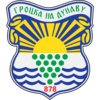Ritopek
Ritopek (Serbian: Ритопек, Serbian pronunciation: [ri:topek]) is a suburban settlement of Belgrade, the capital of Serbia. It is located in the municipality of Grocka, 20 km east of Belgrade and 19 km west of the municipal seat, on the right bank of the Danube, across from the village of Ivanovo in Banat region of the Vojvodina province.
Ritopek Ритопек | |
|---|---|
Suburban settlement | |
 A panorama of the Danube at Ritopek | |
 Ritopek | |
| Coordinates: 44°44′N 20°39′E | |
| Country | |
| First evidence of settlement | ~500 BC |
| Population (2011) | |
| • Total | 2,613 |
| Time zone | UTC+1 (CET) |
| • Summer (DST) | UTC+2 (CEST) |
| Serbian postal code | 11353 11307 |
| Area code(s) | 11 |
History
Pre-Roman artifacts from the Late Iron Age, have been discovered in Ritopek. The most representative is the Scythian styled pendant from the 5th century BC, a representation of a stylized griffin's head with tentacles.[1] The remains belonging to the Scordisci, a Celtic tribe which founded Singidunum, the predecessor of Belgrade, were also found in Ritopek.[2]
In Roman times, the fortress of Tricornium (Latin for "three-horned fortification") existed at the site of Ritopek. It contained an important military camp Castra Tricornia. The name originated from three distinctive hills dominating the landscape, one of which was later washed away into the Danube river. The settlement gave name to the Romanized Thracio-Celtic tribe of the Tricornenses. A ceremonial breast plate with stylistic illustrations belonging to Legio VII Claudia soldier Aurelius Herculanus and dating from 258 AD has been found[3], as have many other artifacts of the Roman period such as silver coins that were washed ashore once the dam of the Iron Gate I Hydroelectric Power Station was constructed.
Tricornium was one of the forts built to protect the Via Militaris road. Other known forts include Mutatio ad Sextum Militare, in Grocka, and Mutatio ad Sextum, in Mali Mokri Lug.[4] Well preserved bust of the Roman emperor Macrinus (ruled 217-218) was found in the nearby Boleč.[5]
The elementary school in Ritopek was one of the first schools in Serbia, established in 1838. Together with the school, the villagers built the first church which was completed in 1868 and is dedicated to the Holy Trinity.
Ritopek is frequently damaged by flooding of the Danube (such as in the floods in April 2006 and those of May 2014).
Economy
Ritopek's economy is almost entirely based on agriculture, especially intensive fruit growing. Vast orchards surround the village. The villagers live off growing cherries, apricots, and apples, and vineyards were farmed in the past. A summer festival, Dani trešnje (Days of [the] cherry) is held in the village. As the village is stretched almost 5 km along the road, new section on the road of Smederevski put is modern, commercially oriented (gas stations, restaurants, workshops, parking lots, etc.), and connects the built-up area of Ritopek with Boleč and Vinča, thus making Ritopek the easternmost part of the continuous built-up area of Belgrade.
Population
Ritopek is statistically classified as a rural settlement (village). Historical population of Ritopek according to the official censuses:[6]
- 1921 - 1,540
- 1948 - 1,892
- 1953 - 1,980
- 1961 - 1,956
- 1971 - 1,886
- 1981 - 2,002
- 1991 - 2,163 (de jure)
- 1991 - 2,045 (de facto)
- 2002 - 2,349 (de jure)
- 2002 - 2,284 (de facto)
- 2011 - 2,613
References
- "Да ли знате: по коме је Београд добио своје прво име Сингидунум?" [Did you know: who gave Belgrade its first name Singidunum?]. Politika (in Serbian). 18 May 2018. p. 30.
- Ana Vuković (8 November 2018). "Tragom Skordiska u našem gradu" [Trails of the Scordisci in our city]. Politika (in Serbian). p. 15.
- "Pektoral" [Pectoral (shield)]. Virtuelni muzej Dunava. 2012.
- "Discover Belgrade - Ancient period" (in Serbian). City of Belgrade. 2018.
- Marko Popović (2011). Dragan Stanić (ed.). Српска енциклопедија, том 1, књига 2, Београд-Буштрање [Serbian Encyclopedia, Vol. I, Book 2, Beograd-Buštranje]. Novi Sad, Belgrade: Matica Srpska, Serbian Academy of Sciences and Arts, Zavod za udžbenike. p. 37. ISBN 978-86-7946-097-4.
- Uporedni pregled broja stanovnika 1948, 1953, 1961, 1971, 1981, 1991 i 2002 - podaci po naseljima (in Serbian). Belgrade: Republički zavod za statistiku. 2004. ISBN 86-84433-14-9.
External links
| Wikimedia Commons has media related to Ritopek. |
